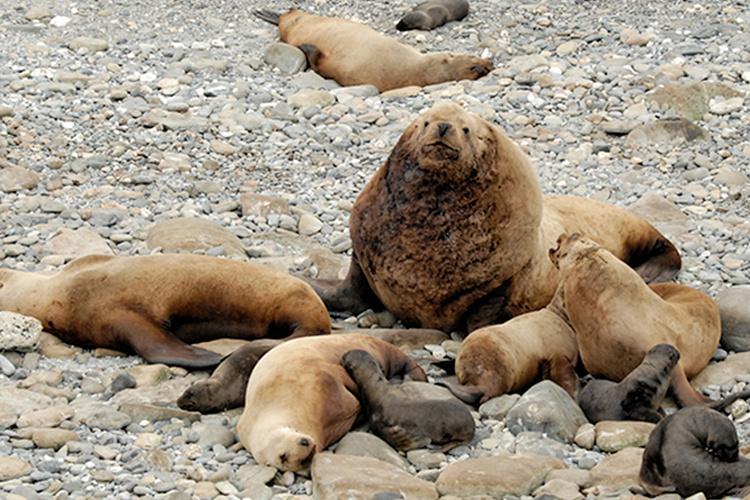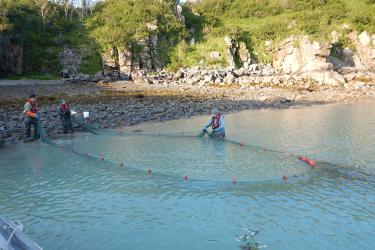This week a team of scientists from the Alaska Fisheries Science Center begins surveying for Steller sea lions in the western portion of the Aleutians Islands – an area where the sea lion population is declining. The survey will be conducted using the U.S. Fish and Wildlife Service's research vessel Tiglax (TEKH-lah), which is the Aleut word for eagle.
Center biologists will survey known sea lion sites to count the animals and look for permanently marked individuals to learn more about their life history. Researchers will also collect images from digital cameras that had been mounted to take photographs of breeding grounds, which are called rookeries. The cameras were also placed at land locations where sea lions gather but do not breed; those locations are called haulouts. The cameras were programmed to capture images year-round, during daylight hours. Meanwhile, the NOAA Twin Otter (a manned aircraft operated by NOAA’s Aircraft Operations Center) will survey the Delarof Islands and the east to conduct a complete survey of Steller sea lions on the Aleutian Islands.

Steller sea lion survey locations.
As the team cruises to the island chain, they are sure to encounter killer whale pods (both resident and transient/Bigg’s) and humpback whales. Biologists on board will take pictures to identify individuals. Hopefully, they will also be able to deploy satellite tags on the whales. Lastly, fish biologists will be towing underwater cameras at sites where satellite-tagged sea lions have been observed foraging for prey. In the Aleutians, that prey is primarily Atka mackerel.
The first leg of the trip will begin in Adak where the eight biologists will embark and work their way to the Near Islands (the westernmost point in the U.S.). The crew will then work their way east beyond Adak, surveying on their way to Dutch Harbor. Five of the biologists will disembark in Dutch Harbor and the remaining Marine Mammal Lab biologists will continue to survey around Dutch Harbor looking for permanently marked sea lions before finalizing the trip in Homer, Alaska, the Tiglâx's home port.
Meet the Blogger

Katie Sweeney
Katie Sweeney is NOAA fisheries biologist participating in the 2016 Aleutian Island Research Survey. During the three week survey, she will post about what the team is doing and seeing. Katie has worked at the Alaska Fisheries Science Center's Marine Mammal Laboratory since 2007. She primarily works on Steller sea lion population abundance and monitoring. She is also involved in life history and demographic studies of pinniped species. During the trip, the team will be using a hexacopter, an unoccupied aircraft system, to capture images of sea lions that are critical for collecting accurate counts and for identifying permanently marked animals. Katie is one of the group's FAA-certified hexacopter pilots.
Katie thinks the best part of her job is traveling to Alaska during the summers to participate in field work on abundance and life history projects. She received her B.S. in Aquatic and Fisheries Sciences from the University of Washington in 2006 and later earned her Master’s Degree from Duke University in 2012. In her spare time, she enjoys backpacking, diving, and traveling as much as possible.



